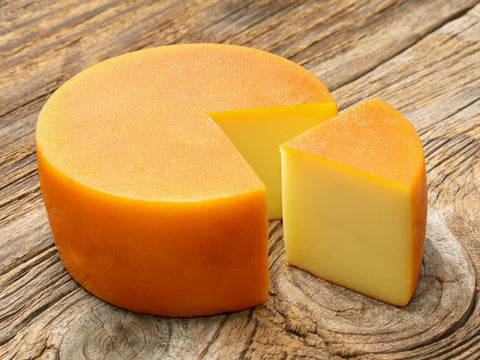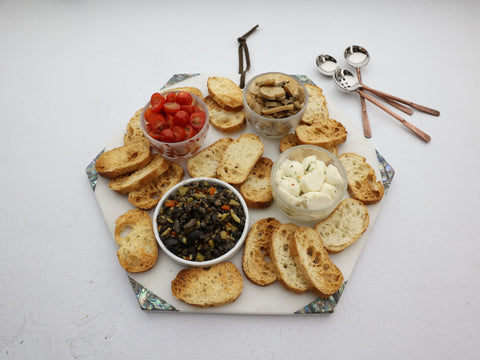
Photo credit: Travel Breath Repeat
Gouda is a charming Dutch city with canals and narrow alleyways.
What is Gouda?
Gouda is a cow’s milk cheese. In Dutch, it is pronounced “how-duh” with a guttural “g” sound. A young Gouda has a mild flavor, which becomes nuttier with hints of caramel as it ages.
It is one of the most popular cheeses worldwide, and these days, the name Gouda can refer to several similar cheeses produced in the traditional Dutch manner.
Gouda varieties range in age from 4 weeks old to cheese that has been aged for over a year. In Dutch, this farm cheese is called boerenkaas, and it is still made using traditional production methods and protected by the European Union.
Gouda cheese has been made since 1184, making it one of the oldest recorded cheeses still produced today. (Parmigiano Reggiano is another example.)
The cheese gets its name from the city of Gouda, in South Holland. You might think because that’s where it was first produced, but it was named after the city because of trade. Back in the Middle Ages, certain cities could obtain market rights on certain goods, which gave them a monopoly on certain goods. Gouda was given the market rights on cheese, so it was the only place local farmers were allowed to sell their cheese. Buyers could sample the cheeses and negotiate a price.
 Photo credit: www.travelbreatherepeat.com/gouda-cheese-market
Photo credit: www.travelbreatherepeat.com/gouda-cheese-market
Today, they recreate this market for tourists, showing the bargaining system called handjeklap, where buyers and sellers clap each other’s hands and shout out prices. The cheeses were then brought to the weighing house (shown in the background of the above photo), and the sale was completed.
How it’s made
Ask any cheese maker in the Netherlands, and they will tell you that it all starts with the milk. Cows are fed lots of fresh grass to produce a soft, delicious cheese. Once the cows are milked, the raw, unpasteurized milk goes through sterile stainless steel tubes, directly to large vats, where rennet is added to begin the cheese-making process.
From there, the curd starts to form and is cut while the liquid whey is drained away. The curd solids are then transferred into wooden molds.
In Dutch culture, cheesemaking was traditionally a woman's task, with farmers' wives passing their skills onto their daughters. Today, there are at least 300 Dutch farmers who still produce boerenkaas (farmers' cheese) traditionally.

Photo credit: Ralf Gervink from Pixabay
Types of Gouda
Young is typically aged between 1-3 months. It is sweet, creamy, and mild.
Cured is aged 4-9 months. It is much firmer and has developed a sharper flavor.
Aged is 10-14 months and is even sharper, with a firmer texture.

Photo credit: Culture Cheese Magazine
Gouda that has aged for 18 months or more is considered extra aged. The cheese now has developed crunchy white tyrosine crystals (see above photo), and the complex sharpness of the cheese mingles with a unique butterscotch sweetness.
Boerenkaas, or farmhouse Gouda cheese, is prized by the Dutch. Thanks to the rich grasses that grow in the low pastures of the Netherlands, this Gouda has a natural flavor like no other.
Baby Gouda is a variety of Gouda that is formed into small 8-ounce wheels. It is a young cheese, so it is very mild and creamy.
Flavored Goudas are produced by adding herbs, pepper, garlic, or nuts. One popular flavored cheese is Smoked Gouda, produced by smoking the cheese over hickory chips in brick ovens.

The smokiness of Smoked Gouda adds another layer to the flavor profile, with the slightly sweet buttery taste of the cheese, with the subtle tanginess of the smoky flavor. The cold-smoked cheese shown here has the addition of jalapeno peppers for a spicy, smoky mix of flavors.

Image by iphotoklick from Pixabay
That’s a wrap!
v In Holland, most Gouda cheese is wrapped in a subtle yellow wax rind.
v Black rinds are reserved for aged Gouda.
v Gouda made with goat milk usually has a white wax.
v In the US, Gouda is wrapped in a festive red wax rind.
How to serve it
In the Netherlands, it is often enjoyed sliced and served on dark, hearty bread for “broodie kaas” (cheese sandwiches), common fare for breakfast or lunch.

Mesa Marble Wood Cutting Board serves as an ideal platter for our smoked Gouda and pear snack for two. The Plateau Cheese Tools 4-piece set helped with the cheese slicing.
Gouda is especially delicious paired with fresh fruit. Here we serve up a delicious snack of smoked Gouda with fresh pear slices and crackers.
Other fresh fruit pairings include apples and peaches. Dried fruits add variety, with cherries and apricots a good choice. Gouda is a versatile cheese and is delicious served with savory accompaniments, like cured meats, olives, and nuts.
Aged Gouda, which has sweeter, complex flavors, is wonderful paired with something sweet like chocolate or even a brownie.
Can you cook with it?
Gouda is king for melting into velvety smooth goodness! Make yourself a grilled cheese sandwich with Gouda as the main event, and you’ll never use anything else. For a macaroni and cheese main dish with surprising flavor depth, melt in some Gouda for a special treat.
How to store it
If you end up with leftover cheese after a party, Gouda will stay fresh for about 2 weeks in the refrigerator. Wrap it in parchment or wax paper and keep it in the dairy drawer of your fridge, if you have one. Otherwise, place it in the vegetable crisper- you want a place where the temperature is stable.
When left with a lot more leftover cheese than you think you can eat within 2 weeks, it may be best to freeze it. Keep in mind that freezing removes a lot of the moisture, so when you thaw the Gouda again, it will be harder and crumblier. Previously frozen Gouda may not be the best for your next charcuterie board, but it will taste just as good as it did fresh when melted on a panini, shredded into chilis and stews, or reserved for your family’s favorite macaroni and cheese.
🧀🧀🧀
Did you enjoy this exploration of Gouda cheese? We hope it’s inspired you to shop our collection of wood boards for charcuterie, marble cheese serving platters, and cheese knives. You’ll be ready to serve and enjoy this mild, creamy cheese with friends and family.
Head photo: The Cheesemaker



